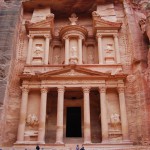Petra (Jordan)
Petra — is one of the most unusual and strangest cities on earth. And the very place, on which the city is located, is unusual and mysterious.
The road to Petra runs south of the Dead Sea towards Aqaba, the famous and only Jordanian resort city on the Red Sea.
Once the legendary “Road of Spices” passed through here. Local sites are well known from the Bible.
Not far away from Madaba, a small city with Christian population, the famous Mountain Nebo is located, upon which Moses died after leading Jewish tribes out of Egypt into the Promised Land.
Closer to Petra there is a narrow long gorge Siq stretching, the walls of which are up to 100 meters high. It is here where Moses struck water out of a rock with his staff. A small dried up river, in the valley of which Petra is located, bears the name “Wadi Musa” – River of Moses.
Later, the state of Edom was established on this territory, which is known from the Bible as the archenemy of Israel. It is in those times when the first fortified settlement appeared on the site of today’s Petra; it received the name “Sela” – a rock. Later it was translated into Greek – Petra (stone).
In the end of IV—beginning of III BC, tribes of Arabs-Nabataeans, who had previously roamed across the Arabia Desert, settled here. The tribes of these nomads got in touch with the Hellenistic-Roman world, with which they had previously conflicted; now they displayed outstanding capacity to perceive and adopt cultural accomplishments of the Antiquity. They adopted written language from Arameans and made it fit their own phonetic system; on this base they created an alphabet, which is believed to be the prototype for today’s Arabic alphabet. And in a hard-to-reach hollow surrendered by overhanging cliffs the Nabataeans founded their capital and began to gradually spread the sphere of their influence from there.
In the last century BC, they were able even to conquer Damascus and make it a part of their kingdom. Romans, who tried to conquer the Nabataean Kingdom, were utterly unsuccessful at first — Petra remained invincible. Scaurus, a famous general of Pompey, experienced in numerous battles, who had got used to victories, had to stop besieging the Nabataean capital. But soon the Nabataeans realized it was better for them to make a union with the Romans. They supported Julius Caesar with their troops during his siege of Alexandria, but after his death helped Caesar’s assassins against the Second Triumvirate. Later, they joined the upper-hand party once again and destroyed the fleet of Antony and Cleopatra on the Red Sea, thus, frustrating their attempt to flee to India.
In I AD, the Kingdom of the Nabataeans virtually became a Roman protectorate, and under Emperor Trajan it was completely conquered by the Romans and became part of the Roman Arabia Province with the capital in Buer. The earthquake of 363 destroyed most of the Nabataean capital. Gradually, its dwellers abandoned it, and for a long time nobody lived in Petra except for nomadic Bedouins.
In XII century, crusaders built a fortress near Petra. After Salah ad-Din’s victory over Christians, its dwellers were converted to Islam.
The discovery of Petra is related to the name of Swiss traveler and researcher Johann Ludwig Burckhardt.
In 1812, dressed as a merchant in such a way that he could not be at first sight distinguished from Muslim pilgrims, he made his way from Aleppo into Egypt through Aqaba. To distrustful Bedouins the Swiss introduced himself as “sheikh Ibrahim,” a pilgrim on his way back from Jerusalem to Cairo. While journeying, he suddenly heard that the famous Petra, the legendary city built in rock, which he had been searching for so many years in vain, is very close…
It all began when Burckhardt found several copper coins near settlement El-Karak. There was an inscription on them in Greek: Petra. From the locals the traveler found out that gold and silver coins were frequently found in the vicinity. Jewelers were happy to buy them.
It was known to Burckhardt that Petra is located in a mining area amid high rocks that were very hard to reach. Ancient geographers – Diodorus, Eratosthenes, Strabo, Pliny, and Ptolemy – were very exact in their description of the city’s location. But neither by geographical nor by historical signs could Al-Karak be the ancient Petra. And Burckhardt decided to research the surrounding vicinities as thoroughly as he could – every settlement, every valley. A huge city could not have disappeared from the face of the earth without a trace!
The quest full of hardships and risks brought Burckhardt to the Wadi-Musa valley. Even while in Syria, he was told that countless treasures are allegedly hidden in this valley. The traveler was accompanied by only one Bedouin guide. On horseback they made their way across an absolutely deserted area passing some forsaken Arab villages. In one of them Burckhardt saw several blocks of marble lying on the road. Where could they have come from?
Pages: 1 2

